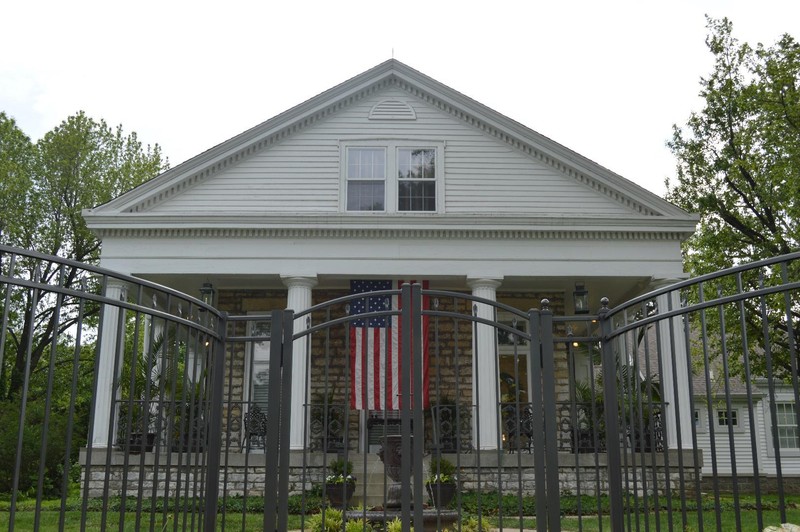William Post House
Introduction
Text-to-speech Audio
The William Post House is a 1 ½ story limestone structure constructed from 1837 to 1838 with the original front section being completed in 1838 while the painted brick rear addition was added after 1860. The building utilizes a Greek Revival design and was added to the National Register of Historic Places in 1980 as an example of domestic early Greek Revival architecture in Illinois built from locally available materials. The home was owned by two prominent Altonians: William Post, a steamboat captain, who later became mayor of Alton, and James Patterson, owner of the Illinois Iron Works.
Images
Post House

Backstory and Context
Text-to-speech Audio
The William Post House is a 1 ½ story limestone structure built in 1838 with an addition from 1860.. In the front, a pedimented gable end rests on a wide entablature (with unadorned frieze) which is supported by four stocky fluted Doric columns which, in turn, rest on a “raised platform”. The pediment and entablature form a porch roof across the whole front of the house. The porch continues halfway down either side; another Doric column and a pilaster on each side of the house complete the side porches. A dentil molding decorates the pediment and heavy cornice. The Post House has a T-shaped plan.
Three strongly vertical trabeated openings, identical in size and symmetrically located, mark the limestone façade. The main entrance is to the right. To the left and center are two 6-over-12 paned, to-the-floor windows. Over the door is a horizontal transom. A cast-iron railing and chunky posts may have been added by the second owner of the house, James Patterson, proprietor of the Patterson Iron Works. The original vertical window in the pediment has been replaced with two smaller windows, giving a more traditional elongated-opening shape. Side windows in the stone structure have simple limestone block lintels with 6-over-6 panes.
In 1922 when William Hancock bought the house, the 20-inch thick stone walls were covered with smooth, incised, two-color cement. Removal of the cement revealed un-mortared stone. Sometime in the 1920’s the stone section was tuck-pointed. Mr. Hancock discovered that no nails had been used in framing the white pine and walnut timbers; the 1830’s house had been fastened together with mortices and pins. Hancock replaced the roof and some rotted roof timbers, changed the stairway system took out some partitions to make larger rooms on the second floor and replaced the wood front porch floor with poured concrete.
The Post House has eight rooms. Unlike traditional three-opening, temple-front floor plans, originally there was no stairway in the front entrance hall; the stairway was in what was then the back of the house. The building has been remodeled by eliminating the rear stairs and adding stairs to the second floor in the front entrance hall. The old rear stairway was rebuilt directly underneath its old location to provide indoor stairs to the basement which underlies the whole front section of the house. A wide hallway crosses the building beyond the rear wall of the original stone portion, two rooms in the brick addition open onto the hall which has exterior doors at each end. The present structure has two interior chimneys.
The Post House is a superior example of domestic early Greek Revival architecture in Illinois built from locally available materials. The home was owned by two prominent Altonians: William Post, a steamboat captain, who later became mayor of Alton, and James Patterson, owner of the Illinois Iron Works.
The Post House is constructed of limestone and timbers from Alton’s bluffs and native forests, fashioned by local masons and carpenters. Woodwork throughout, especially the columns, the entrance way, the interior hall and the parlor woodwork is marked by superior craftsmanship and fine design.
In 1838 William Post had this house built on the State Road north of Lower Alton. Around this time, Post was captain of the steamboat “Columbus”; he later engaged in various Alton enterprises in business, banking, and politics before he left Alton for Litchfield in 1870. William Post was a city assessor (1837), proprietor of the Eagle Tavern (1840) a liquor dealer and grocer (1858) a director of the Alton Mutual Insurance and Savings Company (1862), and twice mayor of Alton (1859-60 and 1866-67). By 1854 Post had moved to William Street in Lower Alton, reportedly to live within the city limits so he could more effectively pursue a political career. In 1854 James Patterson of the Illinois Iron Works purchased the house. Patterson in 1863 took over the factory, renaming it the Patterson Iron Works. The company employed 100 workmen and produced threshers, engines, sugar mills, sawmills, and all kinds of mill machinery. It was Patterson who added the brick addition to the house. Absolom Ash, a plasterer, owned the house from about 1869 to 1871, when he sold it to William Feldwisch. The Feldwisch family never lived in the house; they used it as rental property until they sold it to William Hancock in 1922.
When William Hancock bought the house, it was in poor repair, having been, for some years, subjected to the attrition of a series of renters and vacancies. Mr. Hancock’s daughter, Mrs. William Roller, inherited the property in 1962. The Post House is excellently maintained by the Rollers.
Sources
Researched and Written by Madelyn Knight
Uploaded on behalf of Madison County Historical Society by Kiley Fuchs
http://hpa.illinois.gov/PDFs/200426.pdf
Madison County Historical Society
